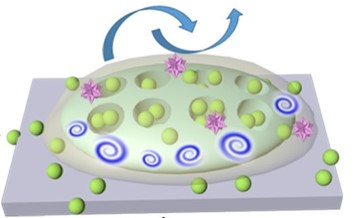Research Team: Oregon State University & Washington State University Vancouver
 The goal of this research project is to explore sensing of biological substances using naturally occurring diatoms, which are a group of single-celled algae found in nature that have been shown to possess unique properties suitable for biosensing applications. This research could lead to new methods to detect many types of biomolecules, which would in turn positively impact pollution monitoring, hazardous material detection, and early disease diagnosis. The integration of this research with education and outreach efforts benefits both graduate and undergraduate students at Oregon State University and Washington State University-Vancouver. Programmatic topics on nanophotonic technology and microfluidics are being added to curricula of these institutions, and efforts are underway to try to broaden the participation of under-represented minorities, women and K-12 students at these institutions through the summer research programs.
The goal of this research project is to explore sensing of biological substances using naturally occurring diatoms, which are a group of single-celled algae found in nature that have been shown to possess unique properties suitable for biosensing applications. This research could lead to new methods to detect many types of biomolecules, which would in turn positively impact pollution monitoring, hazardous material detection, and early disease diagnosis. The integration of this research with education and outreach efforts benefits both graduate and undergraduate students at Oregon State University and Washington State University-Vancouver. Programmatic topics on nanophotonic technology and microfluidics are being added to curricula of these institutions, and efforts are underway to try to broaden the participation of under-represented minorities, women and K-12 students at these institutions through the summer research programs.
The aim of this project is to develop a cost-effective, bioenabled nanoplasmonic sensing technology for rapid detection of histamine and unapproved aquaculture drugs in seafood to enhance food safety. Our technology will be developed through on-chip chromatography coupled with surface-enhanced Raman scattering (SERS) sensing using diatom biosilica. The objectives are: 1) Synthesis of high density diatom thin film with silver nanoparticles that can function simultaneously as a thin layer chromatography to separate toxic molecules from complex food samples and as ultra-sensitive SERS substrates to probe the signature Raman peaks; 2) Quantitative SERS sensing that can detect trace level of histamine and unapproved aquaculture drugs in seafood; and 3) Demonstration of the nanoplasmonic sensing technology for in-situ seafood safety using portable Raman spectrometers through collaboration with local food industry.

Plasmonic biosensors have greatly overcome the limitations of conventional optical sensors in terms of sensitivity, tunability, photo-stability, and in vivo applicability. However, the concerns with average sensitivity, detection specificity, surface functionalities, and device expense still cannot meet the application requirement of point-of-care and personal diagnosis. In this research, the PIs explored dual-mode plasmonic biosensors using bioenabled nanomaterials --- diatom biosilica, with active surface-functionalities as affordable and eco-friendly integration platforms of Ag nanoparticles for label-free detection of biomolecules.
Related Publications:
External Website Link:
Gas and odor sensing plays pivotal roles in energy industry, healthcare, food safety, security, defense, and environmental protection, but it still remains a grand challenge given the stringent requirement of sensitivity and selectivity. So why not learning from our noses that have been perfected by millions of years of evolution. The mammalian olfactory system is well recognized for its ability to identify a large number of airborne molecules, far better than most artificial sensors. The objective of this project is to develop a bio-inspired photonic nose (P-nose) system by mimicking the mammalian olfactory system, which will enable ultra-compact optical gas and odor sensing technology with ultra-high sensitivity and specificity. This research will point out a unique way to advance the frontline research of bio-inspired systems and transcend existing bench-top optical gas sensing technology into system-on-chip level for a broad spectrum of engineering applications.

In this project, we explored the integration of photonic devices with metal-organic framework (MOF) materials for gas sensing. The research includes: 1) An ultra-short near-infrared fiber optic gas sensor using MOF coating; 2) Development of plasmonic nano-structure fabricated on sapphire substrate hybrid with MOF for infrared absorption based gas sensing; 3) a suspended silicon nitride (Si3N4) nano-membrane device integrating plasmonic nano-patch antennas with MOF; and 4) an ultra-compact, cost-effective on-chip near-infrared spectroscopy system for CO2 sensing using narrow-band optical filter array based on plasmonic gratings with a waveguide layer.
Related Publications:
External Website Links: